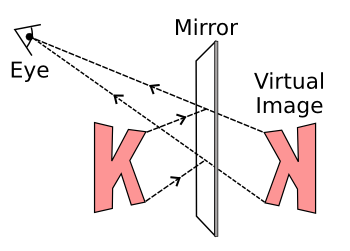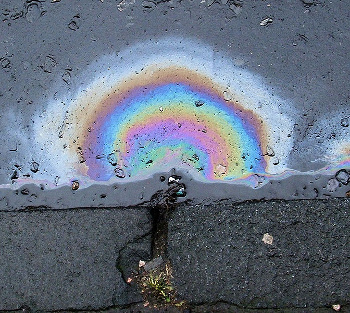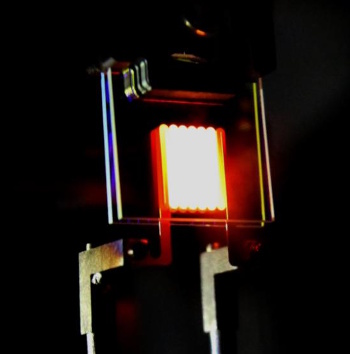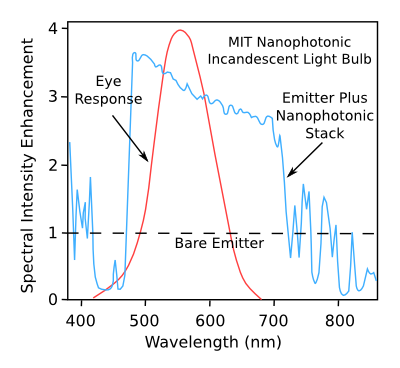Heat Mirror
February 11, 2016
Like
fire, the
mirror is one of those simple
physical objects existing in
nature that caused wonderment and probably advanced our need for
scientific explanation. Without the example of fire and the changes it causes,
chemistry would have advanced much more slowly. The mirror likewise sparked some primitive
theory-building in
early man, giving a jump-start to
physics. As in the example from
Aristotle's On Dreams, shown below, demonstrates, some of these theories were quite imaginative.

"If a woman chances during her menstrual period to look into a highly polished mirror, the surface of it will grow cloudy with a blood-coloured haze." - From Aristotle's On Dreams (Περι ενυπνιου). Greek text via mikrosapoplous.gr. English translation by J. I. Beare via MIT Classics)
Children notice their reflection in a mirror at about six
months of age, but they don't recognize that reflection as an image of themselves. They're just interested in another
face, or the appearance of another child near them. They only recognize the reflection as themselves at about 15-16 months. A simple
experiment to determine when this happens is to put a smudge or
sticker on a child's face, and see whether he or she will grab for it on themselves when looking at a mirror.
Another curious thing about mirrors is that we see our image in a mirror as a "
mirror reflection" in which
left and right are interchanged, but why doesn't the mirror also swap our
feet and
head? The reason for this is that the
symmetry we see is an "inside-out" symmetry called
parity that's
analogous to having a copy of ourselves walk around to the back of a
transparent mirror and face us.
Richard Feynman explains this in a
YouTube video.[1] I wrote about parity and other symmetries in a
recent article (CPT Symmetry, October 29, 2015).

Diagram of a mirror reflection.
The mantra of geometrical optics is "virtual image." Understanding virtual images helps to explain many optical principles.
(Created using Inkscape.)
Mirrors can be fabricated to be selective in which
wavelengths of light they
reflect, and which they allow to pass through. Dichroic reflectors are
thin-film optical devices designed to allow visible light to pass through while reflecting
infrared radiation. Since infrared light carries most of the heat, such a mirror can be used in front of an intense light source, such as a
halogen lamp, to produce a cooler beam. There must be provision, however, to remove the
reflected heat from a lamp.
The principle behind such mirrors is the
interference of light waves as they pass through an interface of one
refractive index to another. At such an interface, a portion of the light will be reflected, and the rest will be transmitted. By selecting the thickness of multiple refractive layers, the reflected rays can be selected to
interfere constructively or destructively at certain
wavelengths. This is an optical manifestation of
Bragg's law, and modern
material deposition techniques make it easy to produce such multilayer optical films.

One example of thin-film optical interference - A rainbow pattern produced by diesel oil on water.
The thickness of the oil layer defines the color.
(Photo by "John," via Wikimedia Commons.)
Scientists and
engineers from the
Massachusetts Institute of Technology (Cambridge, Massachusetts) and
Purdue University (West Lafayette, Indiana) have put the heat mirror concept to good use in improving the
much maligned incandescent light bulb by trapping the infrared energy to enhance its
efficiency.[2-5] The
luminous flux of this
nanophotonic-enhanced lamp is a factor of three greater than a plain emitter for the same input
power.[2]

MIT nanophotonic incandescent light bulb.
Nanophotonics has enhanced the efficiency of this bulb by a factor of three.
(MIT photo by Ognjen Ilic.)
Incandescent lights operate by
heating a
tungsten filament to about 3,000
kelvin, where it emits
blackbody radiation in which only a small portion of the
spectrum is visible light. For that reason, the luminous efficiency of conventional incandescent lights is just 2-3 percent, while the efficiency of
fluorescent lamps is from 5-15 percent, with
LED lamps coming in at 4-15 percent.[3,5] The MIT nanophotonic lamp used their "heat recycling" structure to put the normally wasted heat back into the filament so it needs less power to heat to its
temperature.[3]
To do this, the
research team first reformed the tungsten filament into a
planar structure with a large
area. The large area made it more efficient in absorbing the reflected heat.[4] The heat-reflecting
photonic crystal was composed of up of 90 layers of
silica (SiO
2) and
tantalum oxide (Ta
2O
5) on a silica
substrate.[5] This combination yielded an efficiency of about 6.6%, and it's believed that a heat mirror of 300 layers with a more complex oxide mix might give 40% efficiency.[2-3,5] An important design aspect was creating a photonic crystal that works over a wide range of viewing
angles while still maintaining the required visible
wavelength window.[3]

Spectral performance of the MIT nanophotonic incandescent light. The photonic crystal had ninety layers of silica (SiO2) and tantalum oxide (Ta2O5) on a silica substrate. (Rendered in Inkscape using data from fig. 4 of ref. 2.)[2])
Although inefficient, incandescent lights have the advantage that they are better at rendering colors, and that's why these lights have been preferred to fluorescent lighting for decades.[4] There may be other applications for the MIT photonic mirror, such as in increasing the efficiency of
thermo-photovoltaics in which the light from heated
materials is converted into
electricity.[3-4] This research was funded by the
U.S. Army Research Office and the
U.S. Department of Energy.[3]
References:
- Feynman: Mirrors, YouTube Video from the 1983 BBC television series, "Fun to Imagine," posted by Christopher Sykes, May 26, 2008. An archive of Feynman videos is available at http://www.bbc.co.uk/archive/feynman.
- Ognjen Ilic, Peter Bermel, Gang Chen, John D. Joannopoulos, Ivan Celanovic, and Marin Soljačić, "Tailoring high-temperature radiation and the resurrection of the incandescent source," Nature Nanotechnology, (Advance Online Publication, January 11, 2016), doi:10.1038/nnano.2015.309.
- David L. Chandler, "A nanophotonic comeback for incandescent bulbs?" MIT Press Release, January 11, 2016.
- Recycling light, Massachusetts Institute of Technology, Institute for Soldier Nanotechnologies, Press Release, January 11, 2016.
- Lester Haines, "Boffins switch on pinchfist incandescent bulb - An efficient new spin on old school tungsten tech," The Register (UK), January 12, 2016.
Permanent Link to this article
Linked Keywords: Fire; mirror; physics; physical; nature; science; scientific; chemistry; theory; archaic human; early man; Aristotle; On Dreams; Greek language; mikrosapoplous.gr; English language; translation; MIT Classics; child; children; mirror stage; month; face; experiment; sticker; mirror image; mirror reflection; relative direction; left and right; feet; head; symmetry; parity; analogy; analogous; transparent; Richard Feynman; YouTube video; mantra; geometrical optics; virtual image; Inkscape; wavelength; light; reflection; reflect; dichroic reflectors; thin-film optics; thin-film optical device; infrared radiation; heat; intensity; halogen lamp; interference of light waves; refractive index; constructive interference; destructive interference; Bragg's law; material deposition; optical interference; rainbow; diesel oil; color; Wikimedia Commons; scientist; engineer; Massachusetts Institute of Technology (Cambridge, Massachusetts); Purdue University (West Lafayette, Indiana); phase-out of incandescent light bulbs; incandescent light bulb; energy conversion efficiency; luminous flux; nanophotonic; power; Ognjen Ilic; heating; tungsten; filament; kelvin; blackbody radiation; emission spectrum; fluorescent lamp; LED lamp; temperature; research; planar; area; photonic crystal; silicon dioxide; silica; tantalum pentoxide; tantalum oxide; substrate; angle; electromagnetic spectrum; thermophotovoltaic; thermo-photovoltaic; material; electricity; U.S. Army Research Office; U.S. Department of Energy.